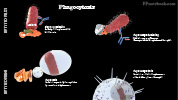Primary Phagocytic Immunodeficiency, Phagocytic Immunodeficiency, Phagocytosis Disorders, Phagocytic Cell Defect, Phagocytic Cell Dysfunction, Phagocytosis, Phagocyte, Phagosome, Lysosome, Lysozyme, Opsonin, Opsonization, Neutrophil Disorder, Neutrophil Dysfunction, Chronic Granulomatous Disease, CGD, Leukocyte Adhesion Deficiency Syndrome, Chediak-Higashi Syndrome
- See Also
- Definitions
- Phagocyte (and Phagosome, Phagocytosis)
- Immune cells (Neutrophils and Monocytes/Macrophages) are White Blood Cells that engulf pathogens and foreign material
- Phagosomes are the membrane engulfed pathogens
- Often combined with lysis by Lysozymes
- Lysosome (and Lysozyme)
- Lysozyme-containing vacuoles produced in cellular golgi apparatus
- Lysomsomes fuse with Phagosomes, resulting in pathogen lysis (esp. Bacterial cell walls)
- Lysosomes, like Phagosomes, are found in Phagocytes (Macrophages and Neutrophils)
- Opsonin (and Opsonization)
- Proteins (e.g. Antibody, complement, C-Reactive Protein) that bind a pathogen surface, targeting it for Phagocytosis
- Epidemiology
- Phagocytic Disorders account for 8.5% of U.S. and 12.5% of European Primary Immunodeficiency cases
- Physiology
- See Also Immune System
- Phagocytes (Neutrophils and Macrophages) are critical to clearing infections
- Phagosomes (Phagocytosis)
- Phagocytes such as Neutrophils (PMNs) and Macrophages attract and engulf organisms (Phagocytosis)
- Phagocytes attract organisms which in turn activate Phagocytosis
- Phagosomes are later lysed via Lysosomes (as below)
- Lysosomes
- Neutrophil's and Macrophage's (Phagocytes) golgi apparatus produce Lysosomes (vacuoles) that contain Lysozyme
- Lysosomes fuse with Phagosomes to produce phagolysosomes, degrading the engulfed organisms
- Lysosomes may also release their contents extracellularly to lyse larger targets too large to engulf
- Complications
- Disorders of Neutrophils or Monocytes/Macrophages
- Fungal Lung Infections
- Recurrent abscesses or delayed Wound Healing
- May present with invasive infections
- Catalase positive infections (consider especially if invasive infections)
- Causes
- Neutropenia - Decreased Absolute Neutrophil Count (ANC<500/ul)
- See Neutropenia
- Chemotherapy-related Neutropenia
- Severe Congenital Neutropenia
- Presents in first few weeks of life
- Omphalitis
- Autoimmune Neutropenia
- Cyclic Neutropenia
- Neutrophil numbers fluctuate in 21 day cycle
- Causes
- Decreased Neutrophil Function
- Chronic Granulomatous Disease (CGD)
- Inherited Phagocyte NADPH oxidase abnormality
- Phagocyte oxidase converts oxygen to Reactive Oxygen Intermediates (ROI)
- Without ROIs (e.g. superoxide anions), Phagocytes can not lyse and destroy engulfed Microbes
- Results in defect of PMN intracellular killing
- Typically diagnosed by age 5 years old
- May first present as omphalitis in infants
- Recurrent in Intracellular Bacterial and Fungal Infections, abscesses and Granulomas
- Examples: Pneumonia, abscesses, suppurative adenitis, gastrointestinal infections
- Inherited Phagocyte NADPH oxidase abnormality
-
Leukocyte Adhesion Deficiency (type 1)
- Adhesion molecules allow Phagocytes to adhere to vascular endothelium and migrate to infection site
- Leukocyte adhesion deficiency presents in first few weeks of life
- Delayed Umbilical Cord separation beyond 4 weeks after birth
- Omphalitis
- Other findings
- Poor Wound Healing
- Erosive perianal ulcers
- Severe Bacterial Infections (e.g. Pneumonia, chronic Skin Infections)
- Chediak-Higashi Syndrome
- Rare Autosomal Recessive disorder affecting intracellular Protein transport
- Immunodeficiency
- Neutropenia
- Neutrophil Dysfunction (defective chemotaxis and bactericidal activity)
- Natural Killer Cell dysfuncton
- Presentations
- Severe infections (often fatal in childhood)
- Lymphoma-like presentations
- Partial oculocutaneous albinism
- Hepatosplenomegaly
- Lymphadenopathy
- Blood count abnormalities
- Anemia
- Platelets deficient in dense bodies (results in Bleeding Disorder)
- Resources
- National Primary Immunodeficiency Resource Center
- Immune Deficiency Foundation
- References
- Mahmoudi (2014) Immunology Made Ridiculously Simple, MedMaster, Miami, FL
- Cooper (2003) Am Fam Physician 68:2001-11 [PubMed]
- Reust (2013) Am Fam Physician 87(11): 773-8 [PubMed]
- Rosen (1995) N Engl J Med 333(7):431-440 [PubMed]
